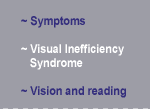

What is it? Visual Inefficiency Syndrome (VIS) is a term we use to represent discomfort and dysfunction in near-vision tasks. VIS may be due to any combination of intraocular, oculomotor, neuromuscular and brain feedback dysfunctions and symptoms that individually and collectively interfere with information processing by the visual system. Inefficient processing of visual information between the eye and the brain can lead to any of the subjective symptoms listed on the previous page. VIS can result in poor reading performance, lower than expected academic performance, poor sports performance and a variety of other problems in any tasks that require rapid or dynamic processing of input through the eyes. During vision screening, Gemstone doctors rapidly determine whether a student might have VIS by measuring the visual behaviors listed below. The criterion for "normal" in each component is set according to published clinical and/or scientific standards, and varies with the age of the student. In VIS, individuals are deficient in one or more of the following areas:
Find out more about the link |
|||||
© 2003 Gemstone Educational Management. All rights reserved.
575 San Pablo Ave., Suite D, Rodeo, CA, USA 94572
Tel.: 510/799-0234 Fax: 510/245-3418

